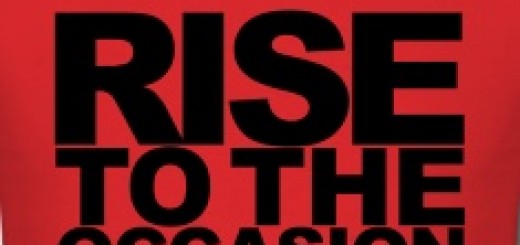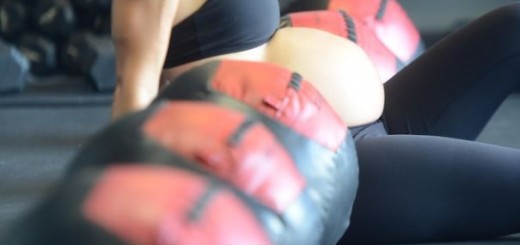Inspiring Confidence In Others
As a mother, wife and athletic enthusiast, Stephanie Sharp shares how she stays positive, balances work and home life and inspires others to walk through life with confidence.
Stephanie Sharp is busy — as a mom, a wife, a CrossFitter, a coach, a box owner, and generally all-around awesome woman. Find out how she is building up Ross Valley CrossFitwith her husband and why she aspires to make sure that every woman walks through life with confidence.
Getting to Know Ross Valley CrossFit
Stephanie: I began gymnastics at 5, and continued to train in that arena until I was about 13. Definitely had Olympic dreams, but multiple injuries kept setting me back. Fortunately, it was around that time that I discovered the weight room. I was the only girl bench pressing and squatting with the guys, which gave me confidence at a particularly challenging time.
I discovered CrossFit in 2006, when a personal trainer that I was working with starting bringing main site WODS to our sessions. All of a sudden, he had me doing kettle bell swings, thrusters, Turkish get ups — all this stuff that seemed crazy to me at the time. It took me a hellacious 18 minutes to finish my first Fran, but I LOVED it! I walked taller that day. So I fell in love with CrossFit, got certified in 2007, and began coaching at a local affiliate. Fortunately, I had access to a lot of experienced coaches, so I got to learn a lot from watching them coach, as well as through being coached by them.
In 2008, my fiance lost his job, so we started thinking about the next chapter… thenI got pregnant in 2009 (perfect timing, of course!), and it was around that time that foreclosing on our home, declaring bankruptcy, and moving in with his parents seemed imminent.
The one thing that kept us sane through the fear and depression of the lifestyle change that unemployment brought was CrossFit. We knew how much it brought to our lives, and just how effective it was. If we were going to go down in flames, we figured that we might as well go out fighting. Then, if we did have to lose everything, we’d know that we did everything we could. So one day we decided to take what little money we had left, in addition to a loan from a family member, and open our own box. Obviously, we didn’t have to move in with his parents.
Stephanie: We opened our doors October 2, 2010, with no members. We currently have 170 members, which is a little shy of our goal for 100 members a year. One of the obvious challenges for us was opening a new business with a 6-month-old. As new parents, you’re operating at a wicked sleep deprivation level, and you’re constantly wondering if you’re doing a good job. Opening a small, service-based business really isn’t any different: you’re taking what you think you know, based on past experiences, and throwing it against the wall to see what sticks. Then, when things inevitably change, you have to be willing to adjust what you’re doing. You can’t get married to one way of doing things. This is true for business, and for babies.
For example, when we opened, we offered all clients 3 private sessions before they could come to class. We felt that the one-on-one time was crucial to teach them everything that they needed to know, as well as to feel cared for enough by us to be motivated to sign up. This was great in theory, but it quickly became evident that this wasn’t time- or energy-efficient. By tweaking our programming for those sessions, as well as opening the sessions up to others, we were able to accomplish our goals in a fashion that made more sense.
Stephanie: Our WODs always begin with a general warm up like running or rowing, then we follow up with a dynamic warm-up that is ever changing and always relevant to the WOD.
80% of the week, we are hitting a strength element at the beginning of the WOD, using a 5×5 or a 5-3-1+ loading sequence, for example. Then we like to hit a little met-con at the end, using the same lift at a lighter load. We might focus heavily on cleans one week, and then snatches the next, then bring those focuses back a few weeks later, pushing the loads and/or reps.
The other 20% of the time, we play around a bit more. We want the strength focus to be there, but we’ve got to provide GPP, or else it’s not CrossFit. So we might throw tire flips, 400 meter runs with chains, toes-to-bar, and handstand holds at them one day, and then work only static bodyweight WODs the next. If the athlete is training with us with the goal of getting in incredible shape, this programming is super effective. Obviously, if an athlete is Games focused, or sport specific, we look significantly deeper at the goals, strengths, and opportunities, and create a training cycle that’s programmed specifically for that athlete.
Stephanie: Six years ago, there were 2 or 3 affiliates in Marin County…now there are 12! But I think that this is fantastic! CrossFit training changes lives on every level, and the more people utilizing it, the better the world will be.
CrossFit boxes are successful when they are owned and operated by people who truly, deeply love to be of service to others. And if you’ve visited different boxes, you can tell the difference between those that are there to serve, and those that aren’t.
Most importantly, it means keeping the athlete’s goal(s) as my number 1 priority. This is harder than it sounds, because every athlete is so different, and requires unique methods of coaching, communicating, and motivation. But our athletes recognize this dedication, and as such, they make our box unique, and they are our greatest marketing tool. We stay true to ourselves and focused on serving others — if your success requires much more than that, you might be in the wrong line of work.
Life-Work Balance
Stephanie: Yoga and CrossFit are a powerful combination, and I have found that advancements in one support advancements in the other. The neurological adaptations that CrossFit supports, such as balance, coordination, and accuracy, are totally relevant to mastering an asana (Yoga pose) And obviously, the increase of flexibility, strength, and power in one becomes evident in the other.
But what’s really cool is how the mindfulness and presence of a yogic practice can make you kick ass in a WOD. My snatch technique leaves much to be desired, and my muscle ups aren’t the prettiest, but when that clock starts, I get in a zone where I’m almost disconnected from my body, but also in total control of it, and I just don’t stop. I feel the muscles fatigue, and my heart pounding out of my chest, but I know that my mind is in control of all of it, and I’m calm. I know where my strengths and opportunities are, and I don’t need nerves to confuse the issue. This is why having a yoga practice is incredibly helpful.
Stephanie: You mean, how do we share the duties of running a business AND a family without killing each other?! It’s an art form. But seriously, we do a great job because we both bring unique abilities to the box that are complementary and absolutely necessary. Nick is a phenomenal businessman, running successful service-based businesses his whole life, and he’s fearless. Because he is a weird human calculator-type, he handles the bulk of the finances, and he also does about 70% of the coaching and programming, consulting with me for input. My time is divided between raising our son, coaching, and handling all the client service details, as well as community outreach and marketing. We do what we are good at, learn about the things we aren’t so good at, and it seems to work.
Stephanie: Training women is important to me because when a woman starts to love her body, which can only authentically happen after lots of hard work, she becomes confident, more assertive, and more in charge of her life in every arena, thanks to an awareness of her abilities.
Women require a special element in coaching as they typically walk in the door with more emotional needs than men. That’s not to say that men aren’t emotional, or that all women are softies. But a woman’s training can be impacted by her emotions in a more significant way than a man’s, generally speaking. Women are more prone to taking on inaccurate and self-defeating beliefs about themselves than men, for a multitude of reasons. As such, they’re the ones who say “I can’t” or “I’ll never be able to do that” the most. Getting a woman to stop believing that noise is a crucial part of coaching her to her optimum level of success.
Stephanie: I’m still trying to figure this one out. It really is about taking it one day at a time, and doing my best to support myself in my own needs. I know that I need to train regularly to stay sane. To insure that I do this, I make sure to schedule myself an hour session, just as I would any other client. Every couple months, I take a weekend away by myself. That time away rejuvenates me, and enables me to give more to others. I also have a spiritual practice that keeps me focused on what’s really important, and that’s my happiness. If I’m not happy, healthy, and embodying all the characteristics that I tout to others, how am I supposed to inspire and motivate?
The hardest part of any given day is wishing in vain for more hours in the day!!!
Stephanie: If I didn’t have a CrossFit box, I’d be researching and publishing articles full time about health, fitness, and the mind-body connection. I’d love to create an outreach program for young women that uses CrossFit training as a medium for developing self-love and confidence. But then, other times I dream of joining the circus, but that’s usually after my kid has thrown his lunch in my face, broken the DVD player, and told me “No!” a million times.
Original Article by: Stephanie Sharp at TabataTimes











